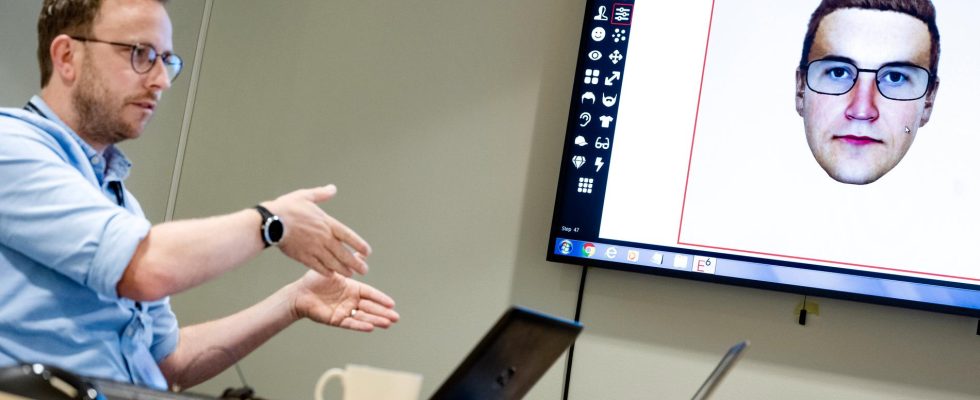1 / 5 Photo: Pontus Lundahl/TT
Already today, the police use the information in DNA to produce images of a suspected perpetrator. Then it takes place through American companies.
Now Swedish researchers will find out how reliable the method is.
Imagine a brutal murder, no witnesses. The police have no idea what the perpetrator looks like. But there are traces in the form of DNA. Hairs and pieces of skin that do not belong to the victim have been found. Could dna be the most reliable witness of the future? A witness who does not forget or is affected by the stories of others?
– The most serious crimes are increasing and we have to grasp at every straw, says Jan Staaf, investigator at the serious crime group at the police in Norrköping.
Staaf has used the method via the American company Parabon Labs on four occasions in criminal investigations. Their business idea is to produce facial images based on DNA. The double murder in Linköping in 2004 is an example where the DNA-generated image pushed the investigation forward so that the murderer could finally be caught.
Reliable?
Forensic geneticist Andreas Tillmar sits at the Forensic Medicine Agency in Linköping. Here, people are used to using DNA to solve legal issues. If there is a suspect, DNA from him can, for example, be compared with DNA from a crime scene. But producing a picture based solely on DNA is new.
– We saw that the police turned to an American company and wanted to find out how scientifically reliable it is, says Tillmar.
But dna has been used in the Swedish legal system to provide clues about appearance and ancestry ever since 2006. It is, for example, about biogeographic origin, that is, approximately where in the world one comes from. But now the researchers want to take it further.
Research project
In the first part of an ongoing research project, Tillmar, together with Heida Rún Bjarnadóttir, among others, has produced facial images from the DNA of 15 voluntary participants. It is about skin, hair and eye colour, but also variables for face shape, the degree of freckles and the probability of being bald and grey-haired.
Unlike, for example, paternity tests – another area where the Forensic Medicine Agency conducts analyses – you do not get exact answers to an appearance. How we look is determined by a variety of genes and it is also influenced by environmental factors. A big challenge is to communicate the uncertainty to those who receive the information, that it is about probabilities.
This is how a text response can look that belongs to an image: “The result of the dna analysis possibly suggests that the unidentified individual has blue eye color and blond hair. Furthermore, the results suggest that the unidentified one has a biogeographical origin from Europe.”
When evaluators had to match the images produced with photos, it turned out to be not entirely easy. Some phantom images were significantly more similar to the real person than others. One of the fifteen, no one managed to link to the correct image.
– In addition, the evaluators were different at matching correctly, says Tillmar.
There are challenges
Overall, the accuracy was between 27 and 80 percent. But Tillmar believes that the technology will develop and, as I said, it is already being used.
– The images produced can provide guidance. It can also exclude certain tracks. But a big challenge is that the appearance can change, dna doesn’t know if someone has dyed their hair or grown a beard.
In the programs used by the Swedish Medical Examiner’s Office, it is possible to change the facial images. For example, you can regulate skin tone, age, hairstyle and freckles. It’s a bit like creating a character in the Sims computer game.
Tillmar’s genes reveal that his hair color is 30 percent red, 30 percent brown, and 30 percent blond.
– I don’t think that this method will be used next year, but in the future I am quite convinced that it will be able to become an important part of certain investigations.
Larger study
The researchers will now proceed with a larger study involving 50 individuals. If it turns out that there is good scientific support for the method, it may be possible for the Swedish Forensic Agency to perform the service or to hire a company.
Police officer Jan Staaf is careful that images produced with the help of dna are there to help the investigators in their work. Not for publication to the public.
– It is life-threatening, then you get hundreds of tips that are completely irrelevant, he says.
– This also applies to other types of phantom images produced with the help of testimonies. If the investigation team should choose to publish the picture in the media, it is probably a way to grab a last straw before the investigation is put to rest.
FACT That’s how it works
In the lab, DNA variants are produced from human tissue.
DNA sequences are read and the result is probabilities for where in the world the person comes from, a certain eye color, skin color, hair color and so on.
That information is fed into a software that makes a suggestion of a facial image of the person.
Read more
